Marseille host Lille at Stade Vélodrome on Sunday, 20 September. After edging through against Brest with the score of 2-3 and winning 0-1 in the Le Classique derby against Paris Saint-Germain which was decorated with red cards, Marseille were in hot form. However, Dimitri Payet and co. finally fell to their first loss in the 2020/21 Ligue 1 season against Saint-Étienne last Thursday. L’OM were the more dominant side in their last match, however, Saint-Étienne were much more clinical in front of goal. André Villas-Boas side managed to create several golden chances themselves but failed to convert any of them into a goal either due to poor finishing or poor luck.
Christophe Galtier’s side, meanwhile, are in a strong form. They haven’t been beaten in any of their first three games in Ligue 1 with one draw in their opening match against Rennes followed by two consecutive wins against Reims and Metz. Galtier’s side have been quite solid defensively with Sven Botman – who was signed from Ajax – quickly forming a solid partnership with club captain José Fonte at the back. However, they haven’t really shown the sharpness in front of goal as they did last season. However, with the season still in its infancy, we might see new signings Burak Yılmaz and Jonathan David develop a stronger and more coordinated partnership.
In this tactical analysis, we’ll break down both team’s tactics and give you a preview of what is to be expected tactically and see how the hosts can secure three points at home in their next game.
Predicted lineups

Marseille (4-3-3/4-1-4-1)
Starting XI: Mandanda – Sarr, González, Ćaleta-Car, Nagatomo – Kamara – Rongier, Sanson – Thauvin, Benedetto, Payet
Lille (4-4-2/4-2-3-1)
Starting XI: Maignan – Çelik, Fonte, Botman, Bradarić – Ikoné, André, Soumaré, Bamba – David, Yılmaz
Both managers are expected to start their key players in this game. A drastic change of formation will not be expected.
Villas-Boas tends to deploy his side in a 4-3-3 or 4-1-4-1 formation and it is highly likely that he would use either one of these formations against Lille.
With left-back Jordan Amavi still unavailable due to red card suspension, new-signing Yuto Nagatomo may get his first start at Marseille but there’s also a chance that Christopher Rocchia may get a start as a left-back. It looks unlikely that Leonardo Balerdi will start as a left-back again in the next match. Villas-Boas may also get creative by playing Hiroki Sakai on the right side of the defence and Bouna Sarr on the left or vice versa.
Villas-Boas is likely to stick with Steve Mandanda in the goalkeeper berth as well as centre-backs Álvaro González and Duje Ćaleta-Car. The midfield trio of Boubacar Kamara, Valentin Rongier, and Morgan Sanson is also likely to be played though there are also possibilities that Pape Gueye, Kevin Strootman, or Maxime Lopez may replace one of the three midfielders. Florian Thauvin and Payet should also be expected to start in the next game with the former playing on the right and the latter on the left. With Darío Benedetto returning from suspension, we could see the Argentinian regaining the starting spot as the striker.
Meanwhile, Galtier is known to prefer starting with a 4-4-2 formation although, at times, he may tweak his tactics a little bit and start with a 4-2-3-1 instead. It is more likely that he’d stick with his favoured 4-4-2 formation though.
It is very likely that we’d see little change in the northern France-based side. Main goalkeeper Mike Maignan is certainly expected to start along with the main centre-back partnership of Fonte and Botman. Mozambican left-back Reinildo Mandava has served his red card suspension and would be available to start in the next game but it is more likely that Domagoj Bradarić would start ahead of him. Mehmet Zeki Çelik is also very likely to start as the right-back after being rested in the previous match.
Two Portuguese central midfielders Xeka and Renato Sanches are doubtful to start in the next game but may be featured on the bench if they pass the fitness test. Meanwhile, Benjamin André and Boubakary Soumaré are both expected to start as the central midfielders. On the flanks, Jonathan Bamba should be starting again on the left side while Jonathan Ikoné starts on the right. There’s also a chance that Yusuf Yazıcı or Luiz Araújo may start on the right side of the midfield ahead of Ikoné. Yılmaz and David are also predicted to start against Marseille though there are also possibilities that Galtier may try out different partnerships upfront as well.
Marseille’s reliance on pace and verticality
Marseille are known to be a direct and vertical-oriented team. Though they tend to play out from the back, they seem intent on getting the ball forward quickly, constantly looking to play the ball into space behind the opposing team’s defence. They tend to attack down the flanks but there are occasions where they would look to progress the ball through the middle instead. They don’t really stick to one particular way of attacking and will adapt to the opposing team’s defensive tendencies. For example, against teams who defend with a compact low block, they may look to retain possession as there’s not much space to exploit behind the defence as well as between the lines. Meanwhile, against teams with a compact mid block, they may try to exploit space behind the defence or perhaps try to use width to stretch the opposing team horizontally and then exploit the gaps inside the opposing team’s defensive structure.
In terms of shape, they are quite flexible with players often swapping positions as well as intentionally leaving their post in order to create an overload in another part of the pitch.
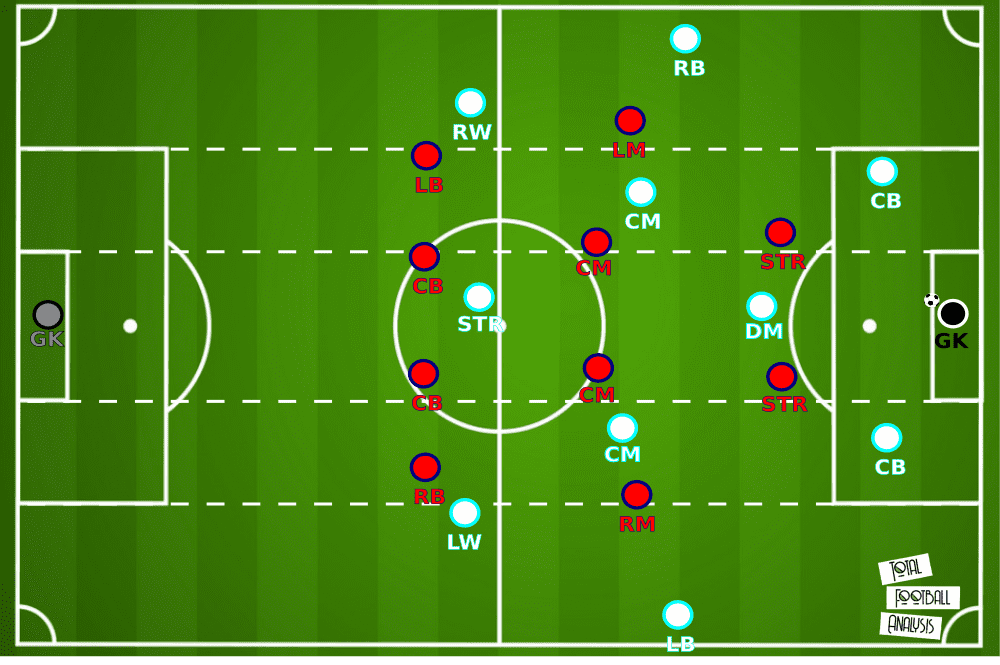
Marseille usually would look to play out from the back with the goalkeeper tending to distribute the ball short towards either centre-back or on certain occasions, directly towards the defensive midfielder. They tend to create a diamond shape, as in the image above, in the early phase of build-up with the two centre-backs splitting, the defensive midfielder sitting deep and centrally, and the goalkeeper getting involved in the action. Marseille also tend to have both full-backs sitting a bit high up the field but if needed, either of them would come down to make themselves accessible.
The two central midfielders tend to occupy the half-spaces. They look to sit high up the field, rather than sitting deep and showing for the ball – though if necessary, one of them will drop and support the backline. By sitting upfield, if a long ball is played, they can make themselves available as layoff options and they’re often also able to quickly press and help win the second ball if the striker fails to win the first ball.
Marseille’s attacking patterns seem quite simple in the eye. They tend to not hold possession for too long and they don’t seem to play a lot of passes, mainly looking to be as effective and efficient as possible.
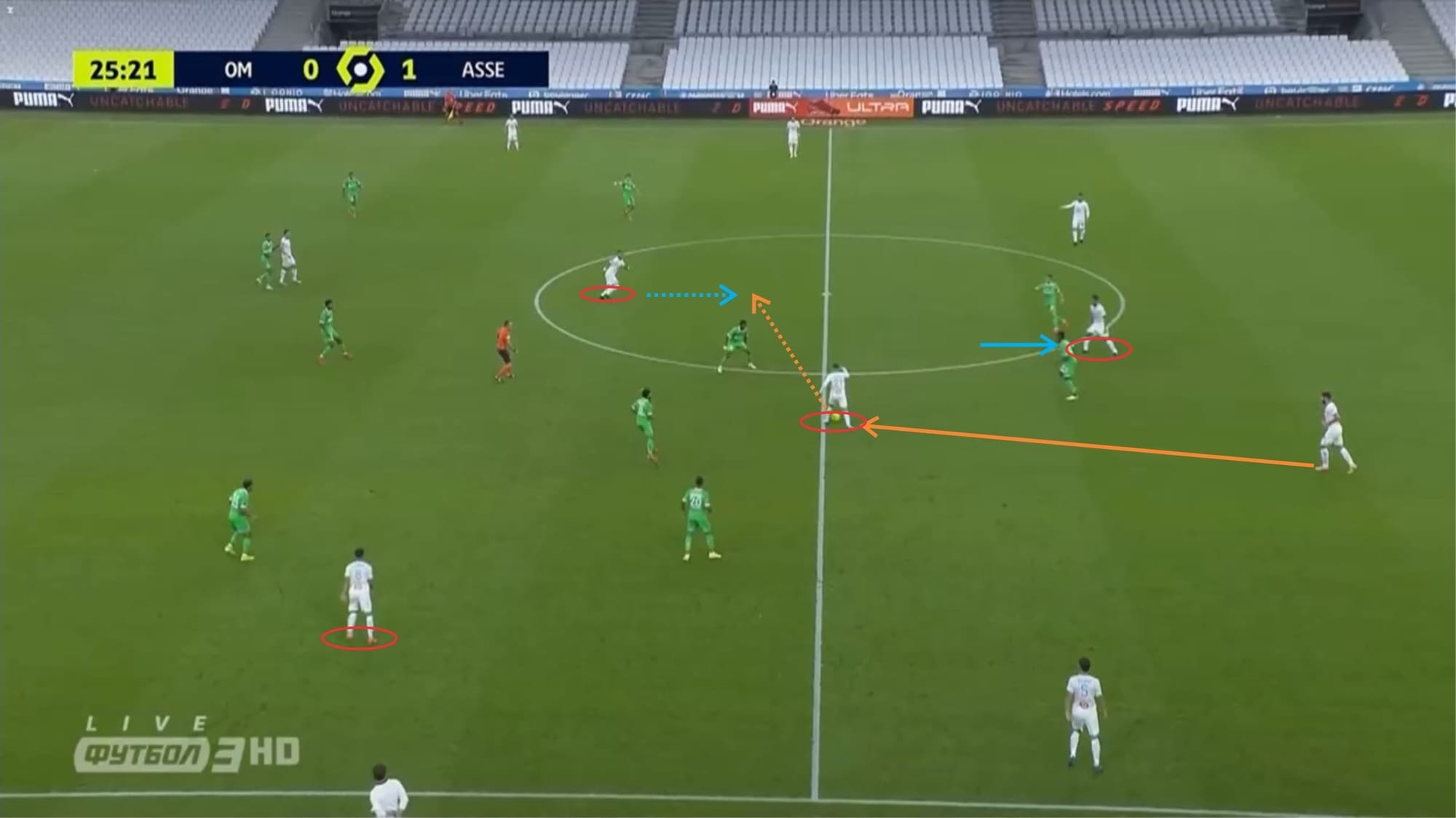
Above is an example of Marseille’s direct build-up and attack. Firstly, what can be seen here is Payet’s positioning. The left-winger switched positions with Sanson who moved wide. Meanwhile, Rongier, who’s deployed as a right central midfielder, moved to the left to open up passing angle and show for the ball. Secondly, you can also see above that the defensive midfielder (Kamara) dropped from his position and slotted in between the two centre-backs in order to attract an opposing marker onto him and open up space in between the first and second opposing pressure line.
Ćaleta-Car passed the ball to Rongier and the latter moved the ball onto the path of Payet.
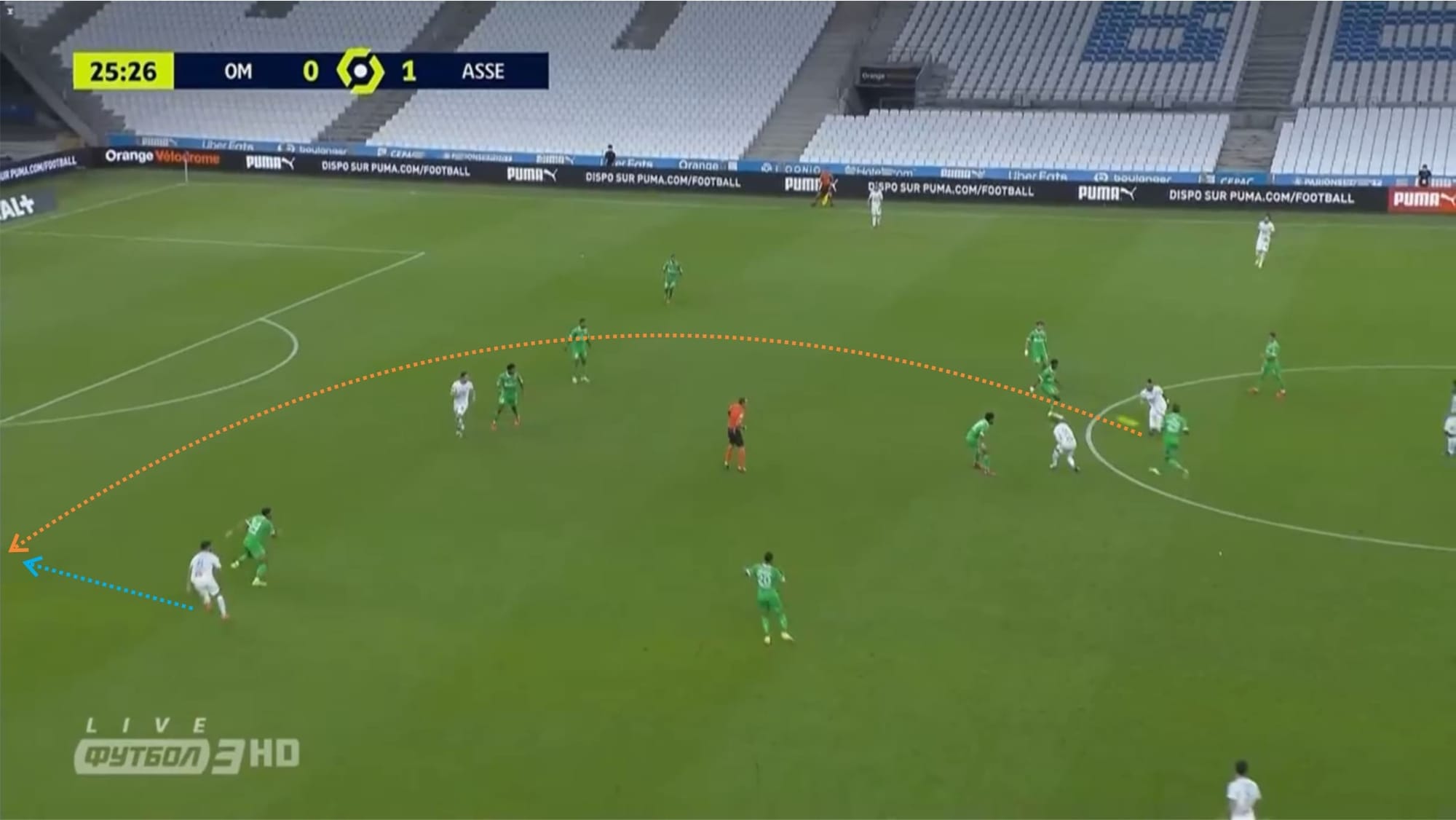
Upon receiving, Payet immediately turned and lofted the ball onto the path of Sanson who made a blindside run behind the shoulder off the opposing defender. The pass in this situation, however, was just slightly too sharp – allowing the opposing goalkeeper to get to the ball first.
Marseille aren’t really a possession-based team. According to their stats, they only have an average of 318.7 passes per game as well as 3.63 passes per possession which are below the league’s average.
We can also see above how direct and vertical-oriented they can be. While possession-based teams would have players moving closer towards the man in possession and offering support by showing for the ball, Marseille rely on having players making runs to create as well as exploit space. This means that most of the time, the man in possession would have multiple options upfront but nearby options may be limited. While this can be exploited by Lille if they can set up pressing traps to isolate the man in possession, Lille also have to be careful of the blindside runs made by Marseille players.
Another thing that Lille need to really be wary of is Marseille’s strength in set-pieces. Out of the four goals, they have scored this season, one came from an extremely pacey break while three others came from set-pieces. Marseille have the likes of Payet and Thauvin as the main set-piece takers while Sanson can also be an alternative. Both Payet and Thauvin are not only good at delivering balls into the box from indirect free-kicks/corners but both can also shoot directly if they got a free-kick in a dangerous position.
How Marseille can exploit Lille
Lille have been quite solid and disciplined in defence. Combining zonal as well as situational man-marking, their defence tend to be quite tough to break.
Usually, when playing against a team who look to play out from the back, Lille would set up a high press. However, throughout the course of the game, they may change their tactics in order to adapt to their opponents. For example, if their high press works well and the opposing team struggle to play out from the back, they would continue doing so throughout the full 90 (unless the opposing team finally decide to start with a long goalkeeper distribution).
But if the opposing team are comfortable playing out from the back despite the high press and Lille’s defence are constantly exposed, they would drop the strategy and immediately set up a compact 4-4-2 mid block instead, which allows the opposing team to play out from the back but makes it difficult for them to progress.
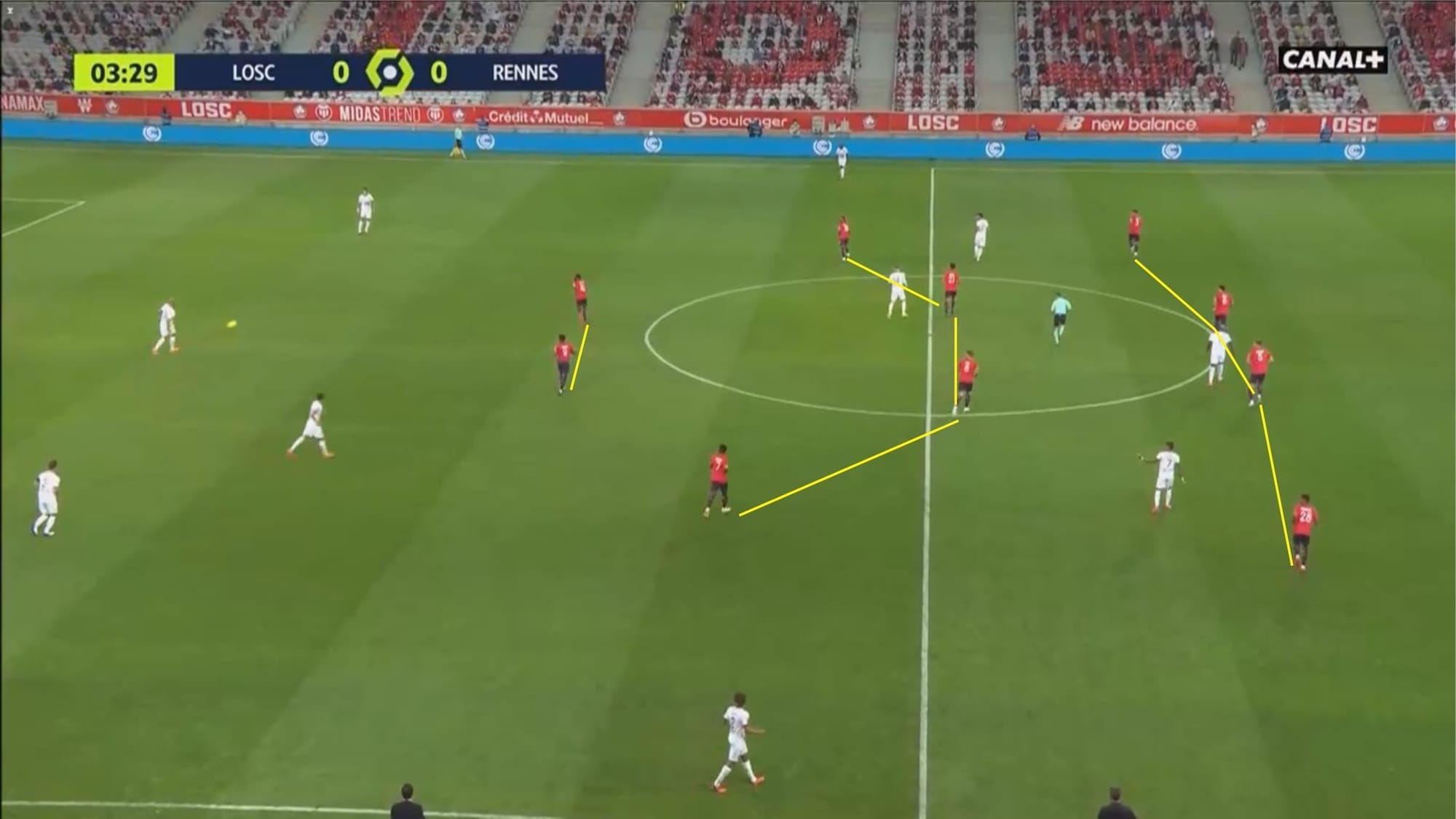
Above you can see Lille’s shape in defence. As can be seen above, Galtier’s side set up a 4-4-2 mid block that is both vertically and horizontally narrow. They aim to deny the opposing team any access in central areas which can make it quite difficult for opposing teams to progress and create chances through the middle.
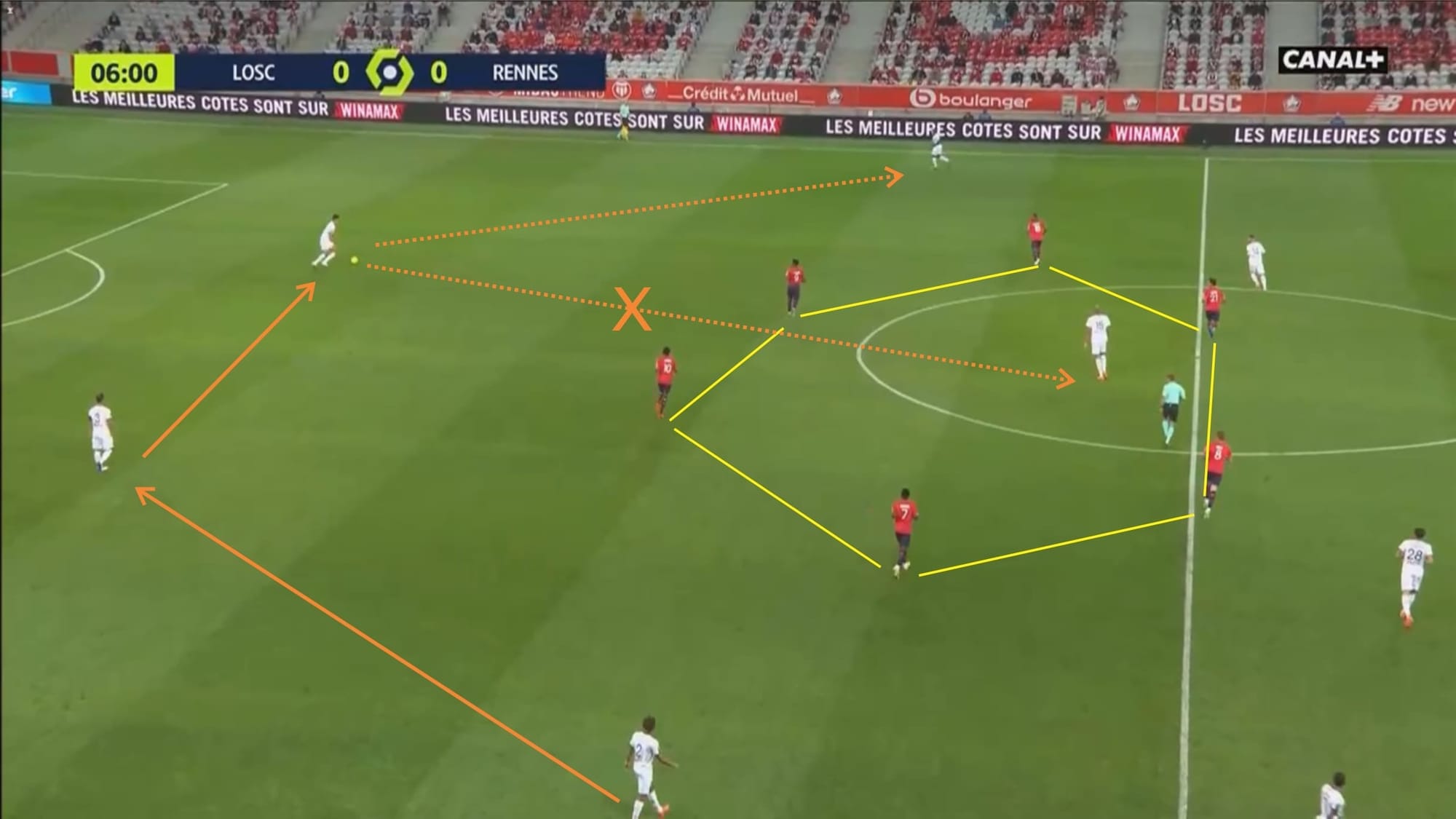
Above you can see Lille’s pressing trap set-up. Playing through the middle can be very difficult against Lille as the opposing playmaker are usually isolated inside Lille’s pressing trap. Usually, instead of tightly man-marking the opposing pivot, Lille central midfielders would let him float around between the first and second pressing line, only following him loosely in order to give the opposing central defender a false sense of safety. Once a ball is played into the trap, players would collapse onto the ball and swarm the playmaker, immediately overwhelming him in order to regain possession and start a counter-attack.
This is why most teams look to avoid the risk of playing through the middle and look to progress down the flanks instead as can be seen in the picture above.
With the block being horizontally narrow, there are naturally quite a lot of spaces left on either flank which can be exploited. However, exploiting the spaces in wider areas may not be as simple as it seems.
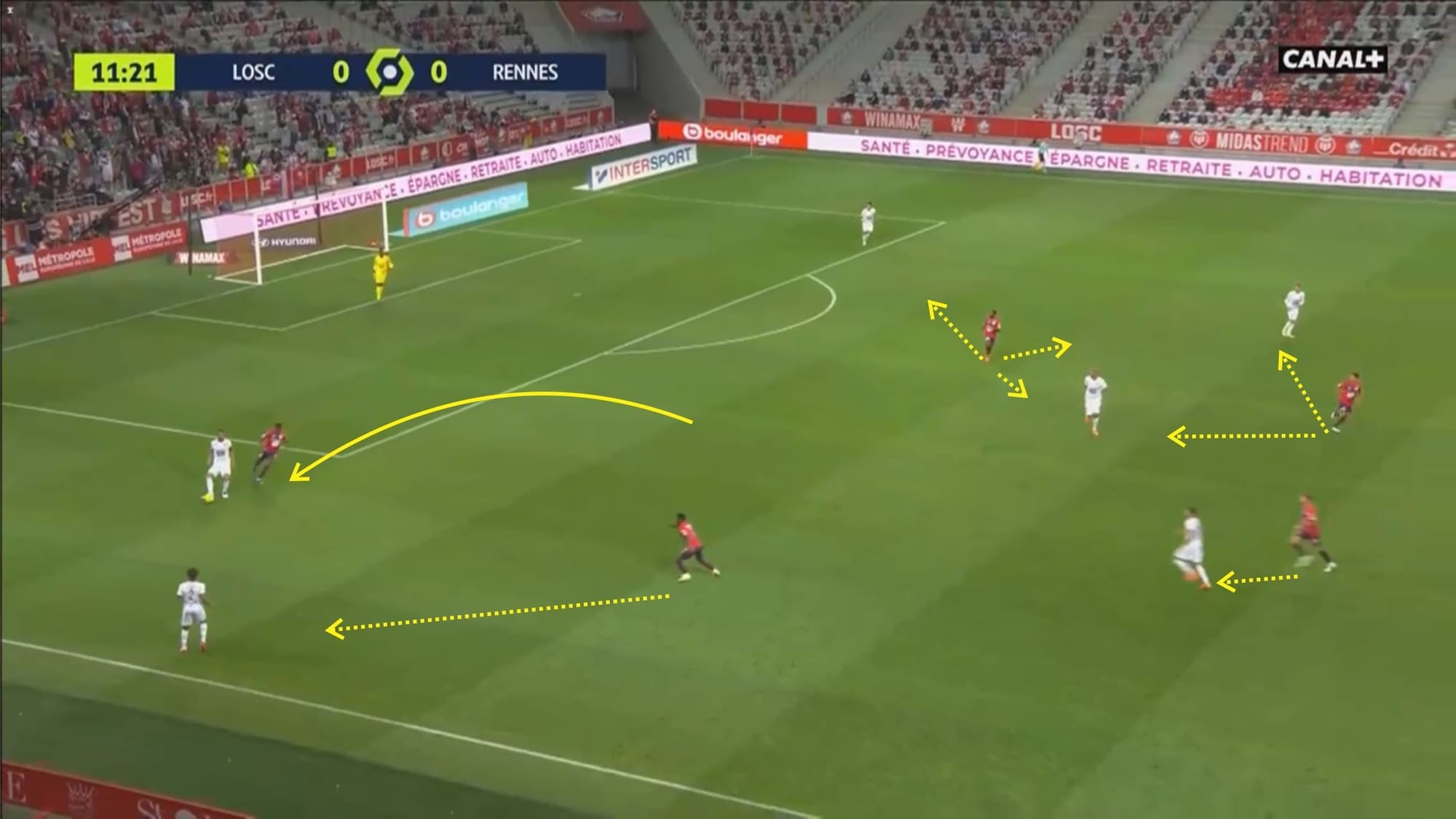
Lille would try to force the opposing team to play through the flanks. However, as can be seen above, once the ball is moved to the flank, they start to shift their block while putting pressure onto the ball. As you can see, Lille’s striker (David) put pressure on the ball carrier whilst steering him wider and narrowing down his space and angle by making a curved run. Meanwhile, Lille central midfielders (Xeka and André) as well as attacking midfielder (Ikoné) try to mark the nearby players.
Above you can see Bamba intentionally gave some space to Rennes’ right-back. With only one visibly safe option in his sight, the ball carrier passed the ball towards the right-back. As expected, Bamba immediately pressed the opposing right-back when the ball was played to him.
Galtier’s side are good at defending against their opponent despite being inferior in numbers in certain areas of the field. They do so by using the aforementioned mix of zonal and situational man-marking. Some players defend mainly man-to-man, some cover both the space/passing lane as well as the man, and some are generally zonal but may defend man-to-man in certain situations or if the ball is in certain areas of the field.
Now let’s see how Marseille would usually build their play up and see what Lille might do to press them.
In the image below you can see Lille imposing a high block in a 4-4-2 shape.
With Lille’s two strikers starting their position near the centre, it would be very risky for the goalkeeper to pass the ball to the defensive midfielder. So, the two centre-backs would certainly be the safest options.
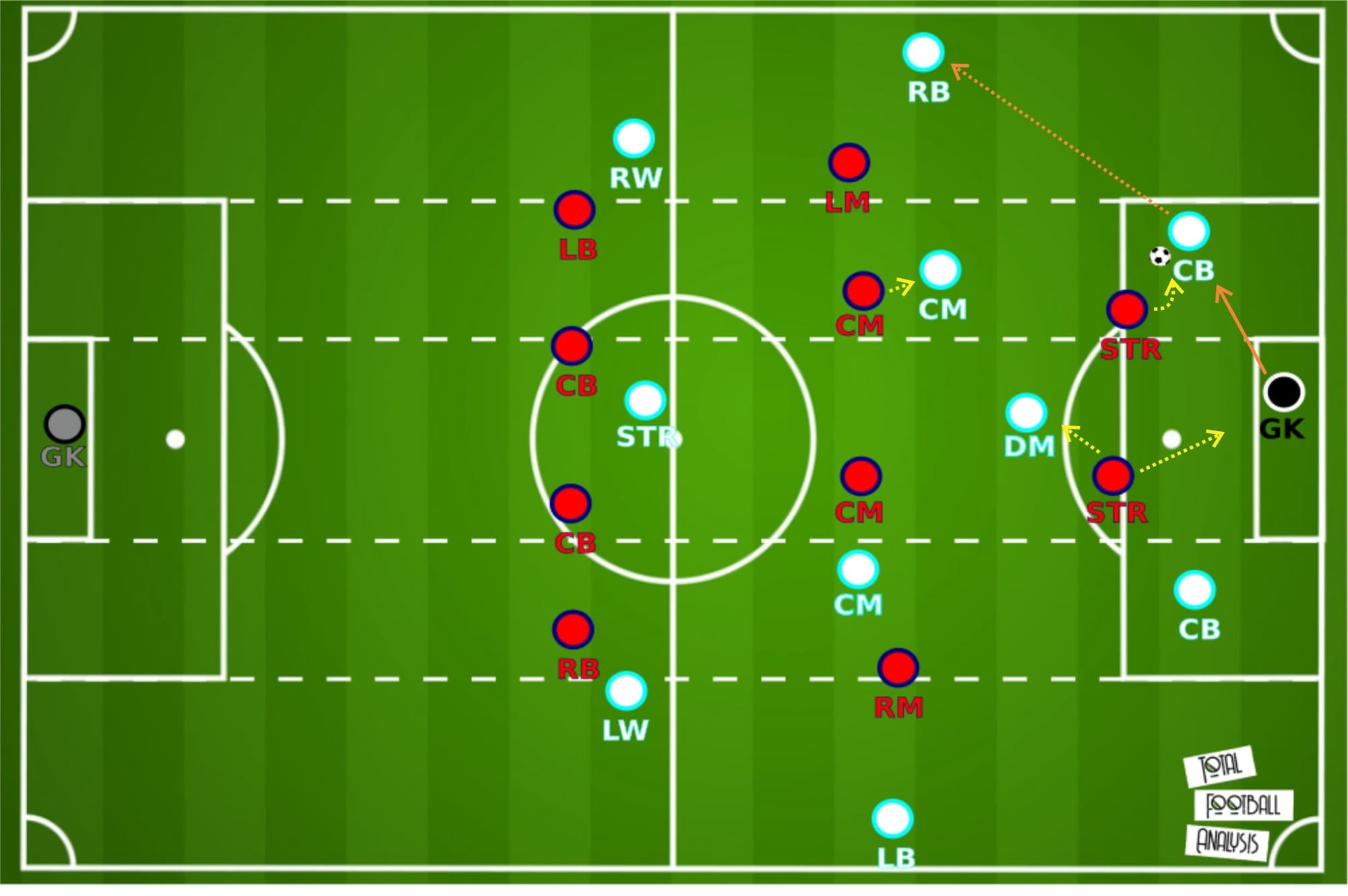
Once the ball is played towards the centre-back, the ball-near Lille striker would approach the Marseille centre-back by making an angled run in order to steer him wide as well as prevent him from playing a pass towards the defensive midfielder. The ball-far Lille striker also would look to prevent the ball carrier from playing a pass towards the defensive midfielder and would immediately press the goalkeeper if the ball is returned.
As can be seen above, Lille’s left central midfielder would man-mark Marseille’s right central midfielder tightly to prevent a pass from being played to him while Lille’s left-winger only mark the right-back loosely to invite a pass.
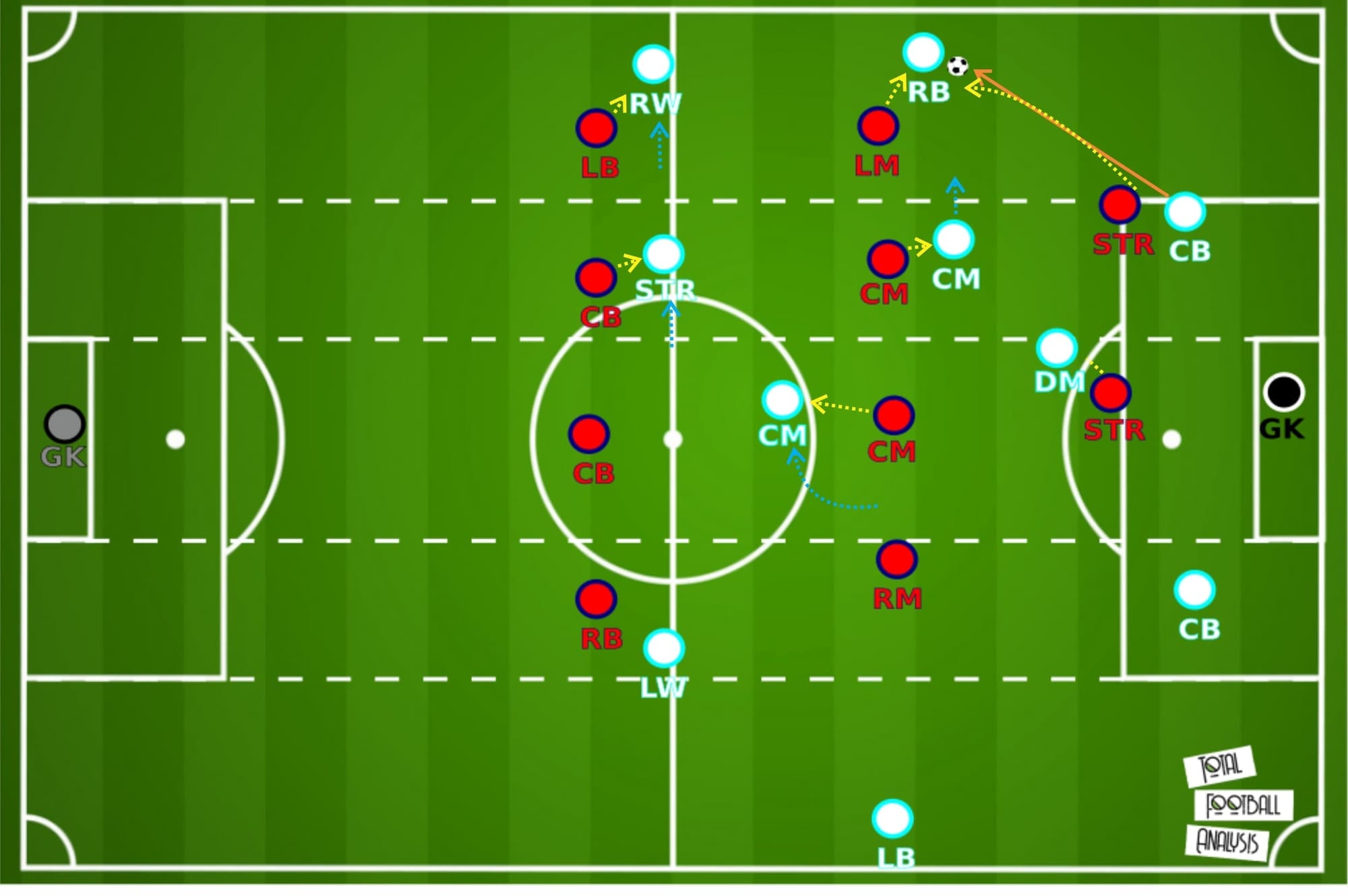
If an anticipatable pass is played, Lille would be able to press and isolate Marseille on the flank, similar to what has been explained earlier in this tactical analysis – potentially recovering possession or at least forcing their opponents to restart their attack.
However, there are some ways that Marseille can use in order to break through Lille’s defence and effectively build their attack. Creating numerical and positional advantages through fluid movements can help them get past Lille’s pressure. Inviting pressure/overloads towards one flank before switching the ball towards the underloaded area can also be quite effective against Lille due to their narrow defence.
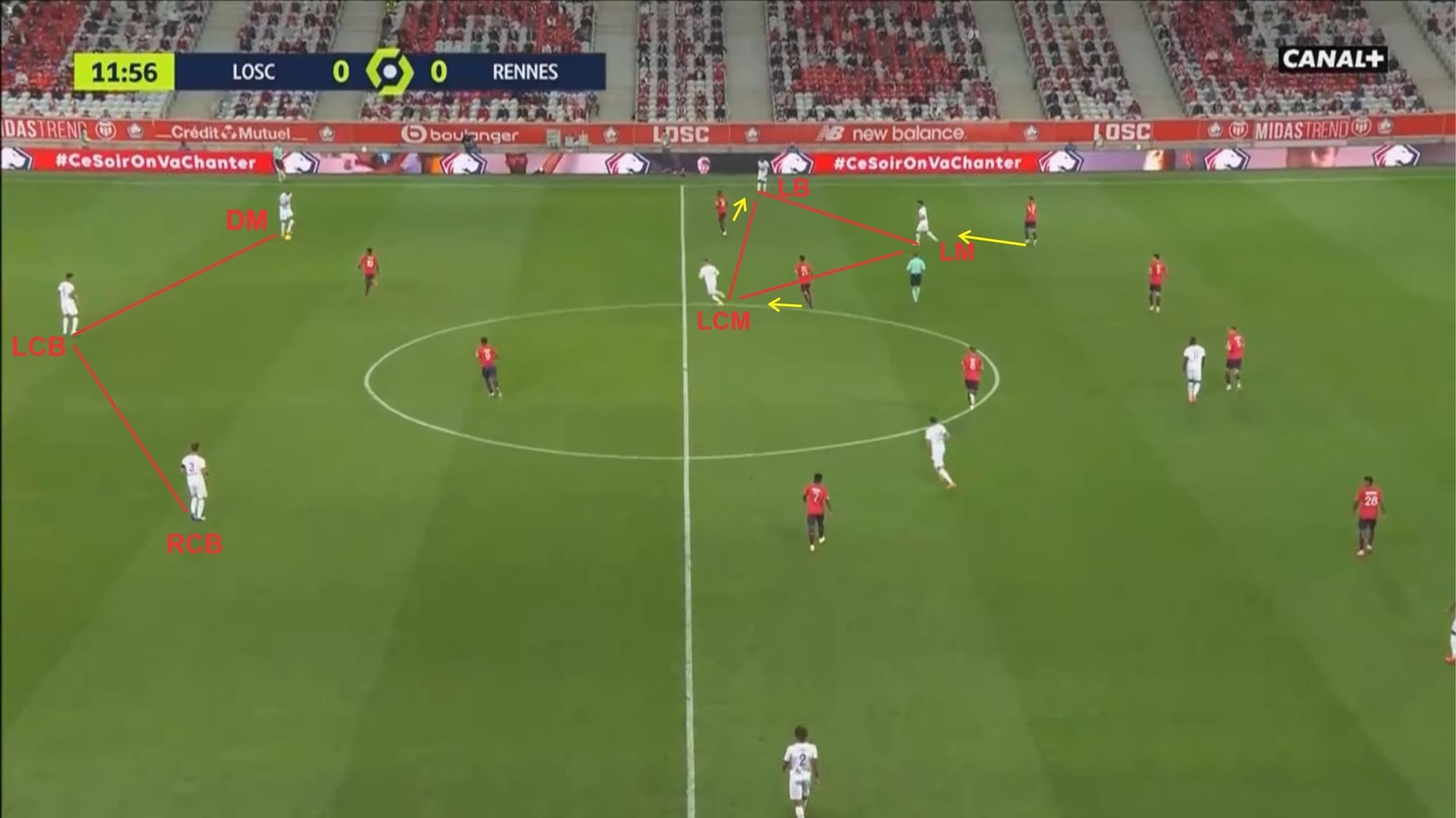
As can be seen above, in their match against Rennes, they had some difficulties dealing with Rennes’ attacks. Julien Stéphan’s side were able to get past Lille’s first line of pressure easily by creating a staggered/unbalanced back-three in the build-up with their defensive midfielder dropping and playing as a wide centre-back or sitting in between the two centre-backs.
They were also able to disrupt Lille’s defensive structure through their fluid movements in the middle third. With players regularly moving around and swapping positions, Rennes were able to open up space as well as create separations in the middle third, allowing them to progress the ball into a more advanced area.
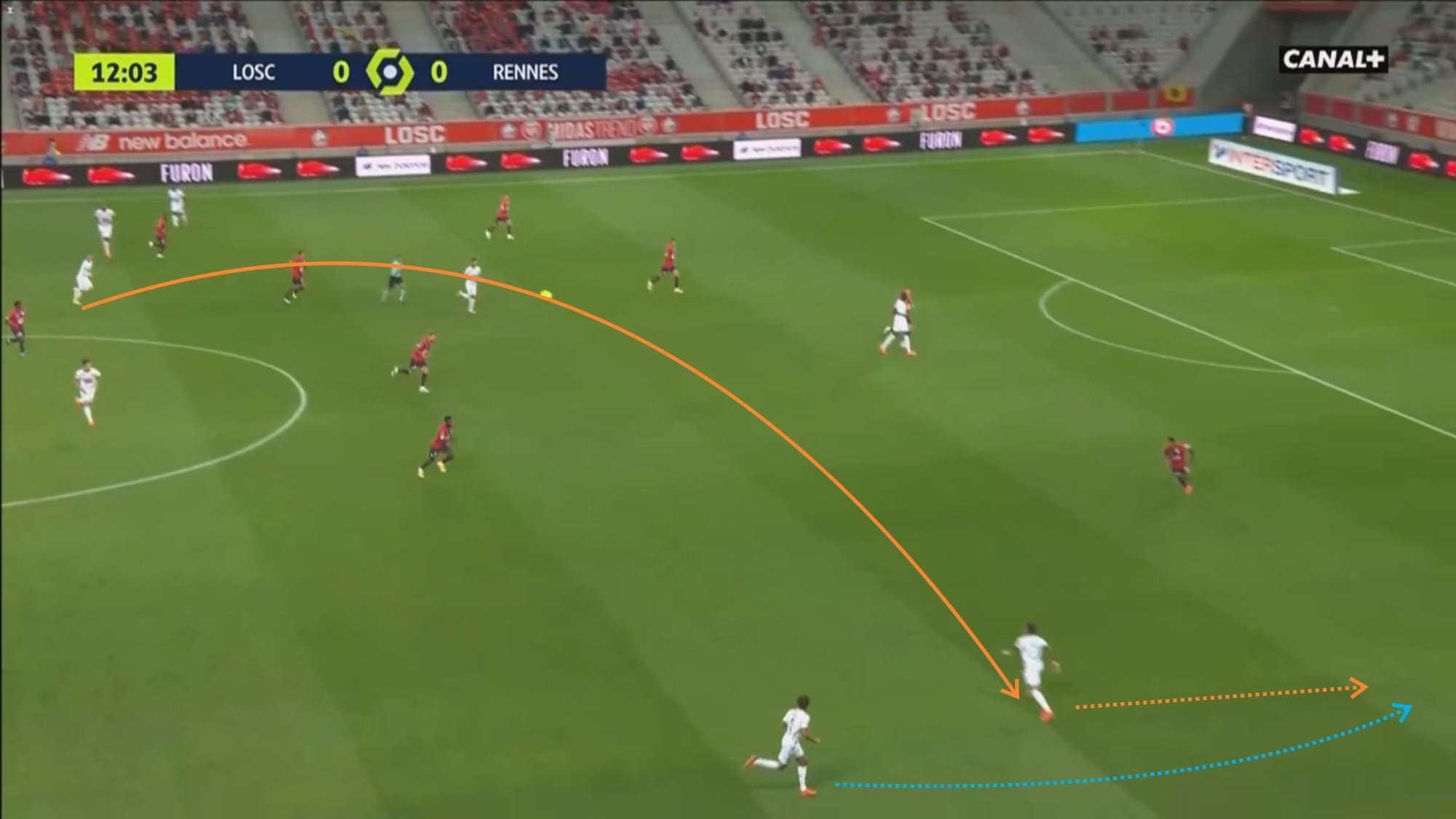
Rennes also exploited Lille’s narrow defence by constantly switching the ball from one flank to another, forcing Lille to quickly shift their block across the field and creating a numerical advantage in the underloaded area by having both their wide midfielder and full-back stay wide. Once the ball reached the underloaded area, as you can see in the image above, Lille’s left-back faced a 2v1 situation and Rennes could take advantage of the situation.
Lille’s attacking approach
Unlike Marseille, Lille seem to turn into more of a possession-based team this season. They mostly look to start their build-up from the back and they look to work the ball forward, relying mostly on high-tempo short pass combinations rather than long passes towards the target man or into space.
In certain situations though, they may choose to be more direct and vertical-oriented.
Usually, last season, Lille would create a 3-1-6 shape when in possession with one central midfielder playing as a pivot while the other one sits higher up the pitch, occupying the half-space.
However, in their first three games this season they seem to show a different tendency as they tend to create a 3-2-5 rather than a 3-1-6 shape as you can see in the image below.
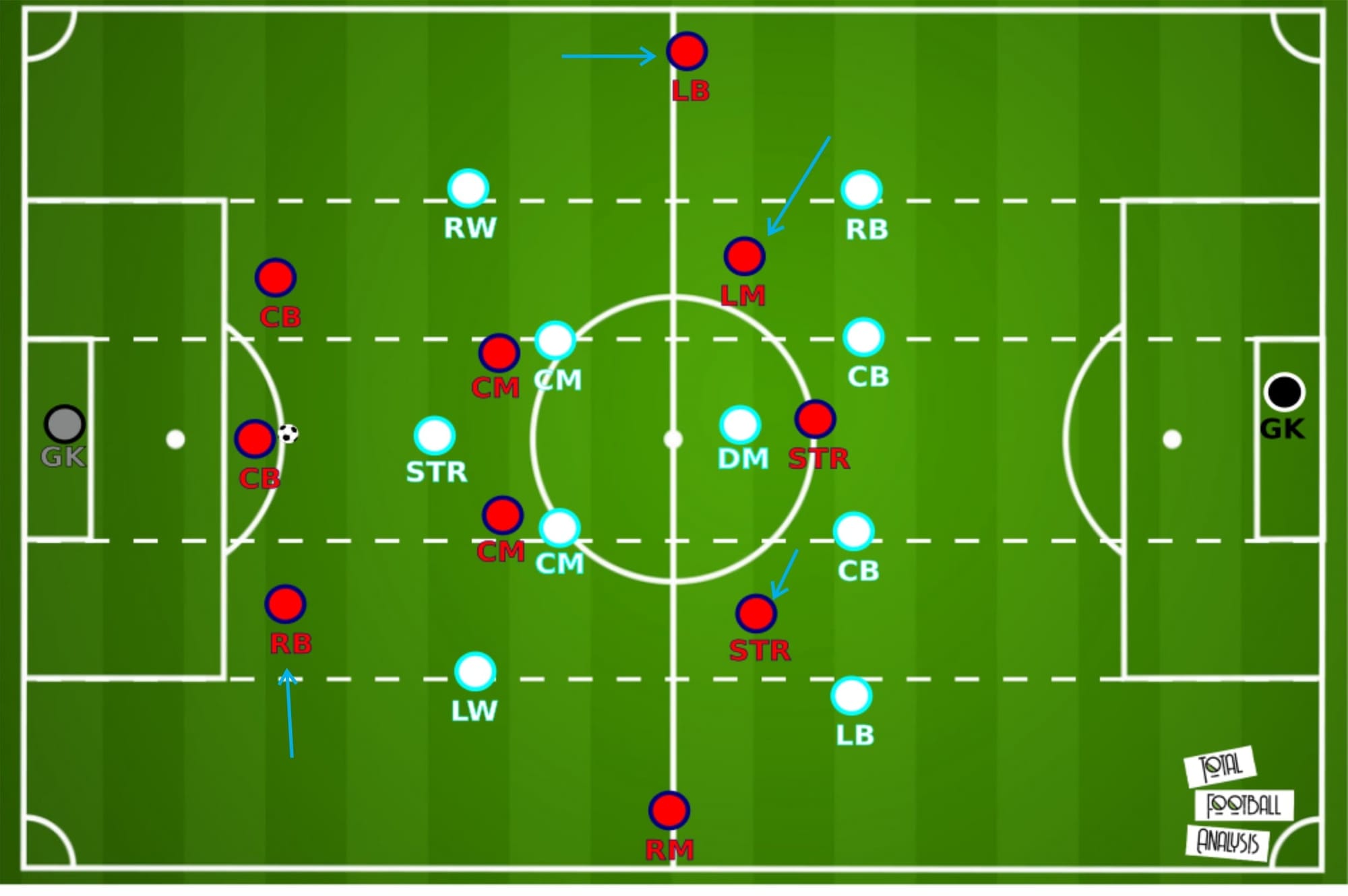
Lille looked to create a back-three consisting of the two centre-backs and one full-back (mainly the right-back, Çelik) that moves inside throughout the match. This is to allow them to rotate possession with more ease at the back.
As can be seen in the image above, while the right-back stayed deep and moved inside, the left-back (Bradarić) will move upfield and sit near the touchline. With the left-back occupying wider position, Lille’s left midfielder mainly looked to explore the half-spaces and float around the spaces in between the opposing team’s second and third line of pressure.
The two strikers seemed to show different tendencies. While Yılmaz mainly stayed upfield and centrally – mostly looking to play off the shoulder of the opposing defender and make runs in behind the defence – David mainly preferred to drop deep and roam wide to provide support as well as help create offensive overloads.
The newly-signed Canadian forward often occupies the right half-space and occasionally drifts wide whilst swapping positions with the right midfielder. The right midfielder, meanwhile, will be looking to float around the space between Marseille’s left midfielder and left-back. With David sitting in the right half-space, the opposing left-back’s attention may be divided between marking him or the right midfielder. Often David will occupy the opposing left-back and drag him inside, opening up space for the right midfielder to receive out wide.
Lille tend to look to create passing angles as well as open up space to progress the ball with combined movements around the middle third. They aim to progress the ball quickly mainly via vertical build-up passing but occasionally, if space opens up behind the opposing defensive line and there’s an opportunity to play a direct through pass into the final third, Lille’s centre-backs or playmakers may opt for the more direct and risky approach.
Lille’s left-back and left midfielder constantly move around and occasionally look to swap position through opposite runs in order to create separation from their respective marker as well as potentially exploit space. A similar tactical tendency can also be seen with Lille’s two central midfielders. Both actively move around to open up passing lanes rather than staying in their place, waiting for the ball.
Galtier’s side will be expected to attack mostly through the flanks and half-spaces but they may also look to progress through the middle if allowed space.
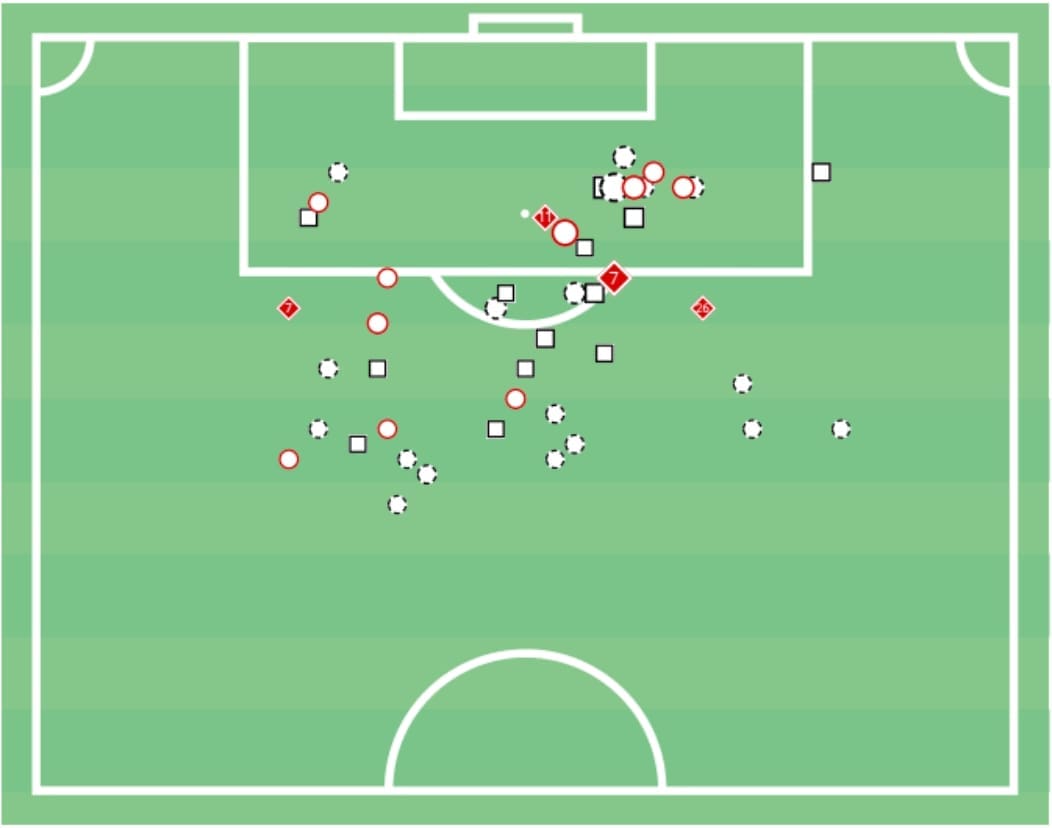
Villas-Boas may also need to be wary of Lille’s long-range shots. In the image above, you can see that Lille produced a lot of shots from outside the box. These shots usually came from Bamba, Ikoné, and Araújo. All of whom like to cut inside from the wings and curl one in from outside the box.
How Lille can break through Marseille’s defence
Marseille tend to defend with a mid block. They’re not a very aggressive team in pressing, usually preferring to immediately sit back and set up their mid block instead of pressing the opposing team high up the pitch. Marseille seem to be more keen on inviting the opposing team upfield and absorbing their attack. Once they managed to regain possession, they will break forward sharply.
However, there are, of course, certain situations that may trigger them to press high up the field. For example, if the opposing team is struggling to progress the ball vertically, they may play the ball backwards or laterally in order to restart the attack. This backwards or lateral pass would immediately trigger Marseille’s press. Villas-Boas’ side would immediately push forward as a unit and pile pressure on the opposing team, not allowing them to restart the attack. This will put the opposing team in an even more uncomfortable situation. As mentioned earlier in this tactical analysis, Lille tend to pass the ball backwards or sometimes immediately play a lateral pass to switch play if a clean vertical progression is not possible so this can be something that Marseille can exploit.
In general, Marseille also use a mix of zonal and man-orientation when defending. However, unlike Lille, who put more emphasis on defending space, Marseille seem to put more emphasis on defending the man.
Let’s take a look at their defensive shape below.
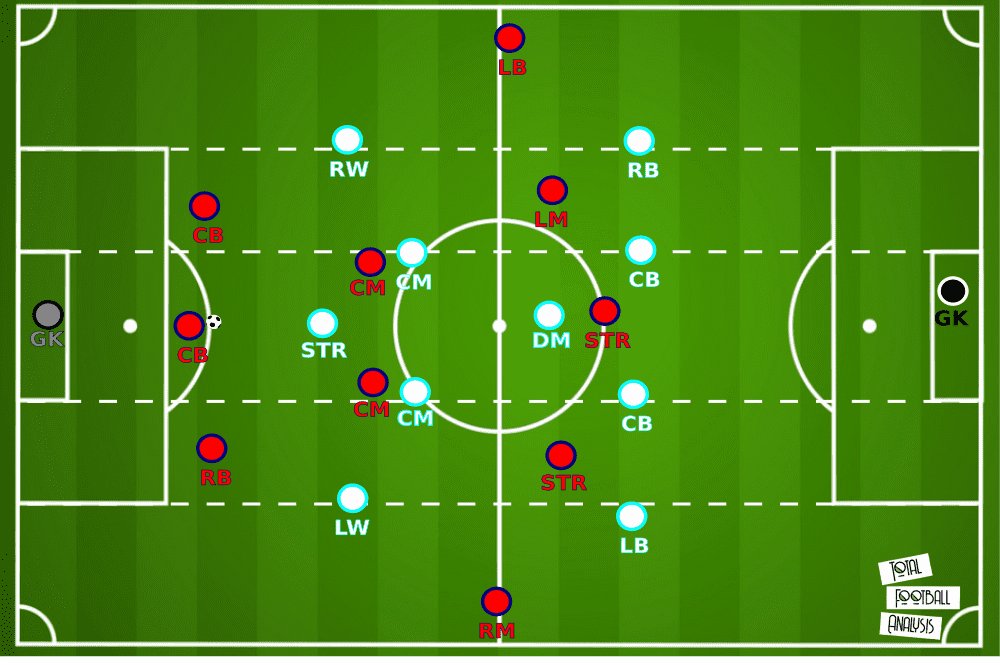
In the image above we can see Marseille defending with a 4-1-4-1 mid block. The lone striker doesn’t press aggressively but still tries to close down the man in possession. The two wingers also tend to defend their respective space whilst putting the opposing wide men in their cover shadow.
The two Marseille central midfielders tend to man-mark opposing pivot(s), preventing the backline from playing a pass towards them. Meanwhile, the defensive midfielder will look to guard the space between the midfield and defensive line. Marseille’s defensive midfielder tends to focus on defending the space rather than following an opponent, however, he will make a compromise in certain situations.
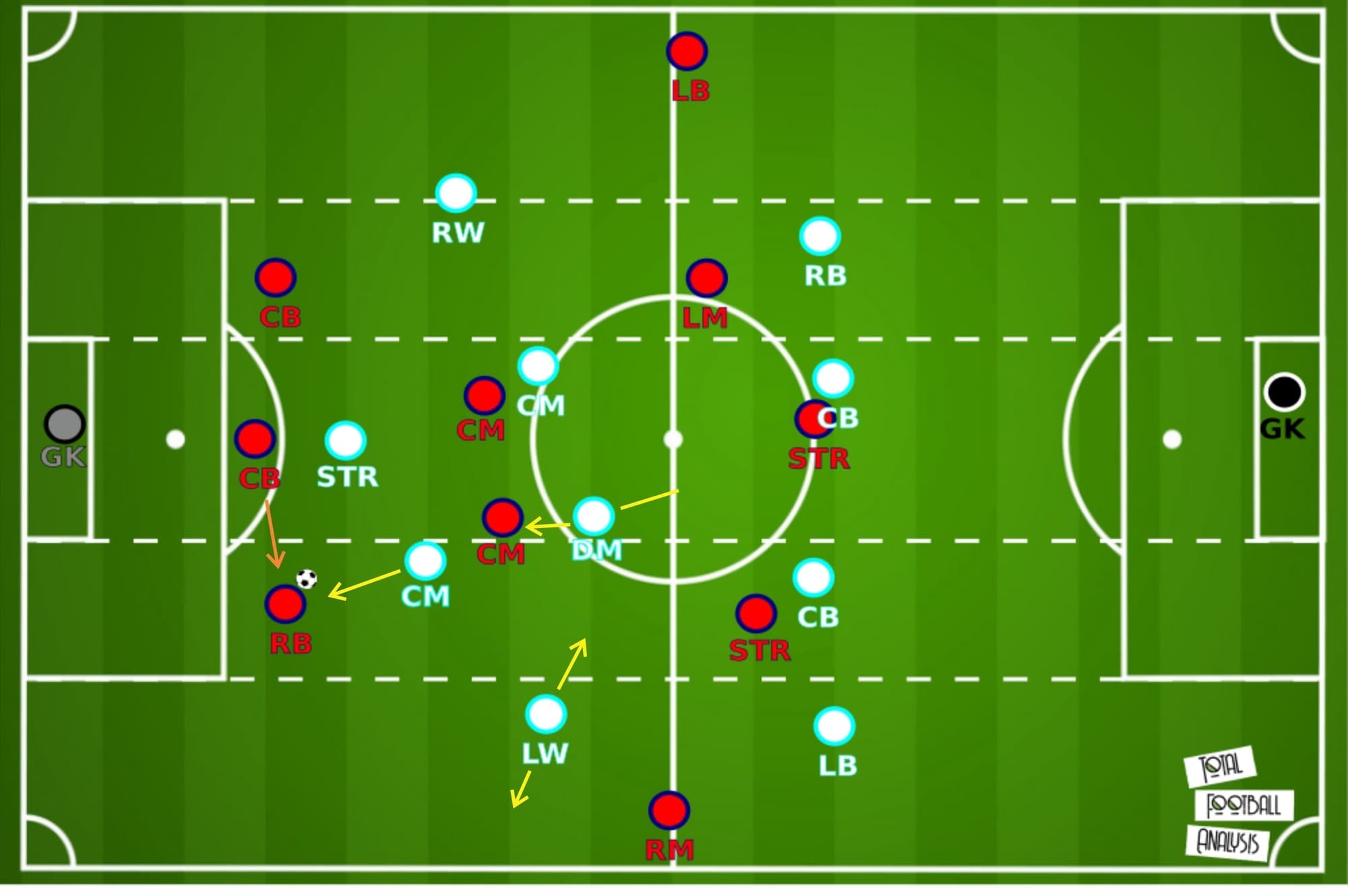
In this example above, the centre-back moves the ball laterally towards the right-back. Marseille’s wingers are usually passive and will opt not to press unless they see a clear opportunity to win the ball – preferring to defend his space and anticipate if the ball is played into the half-space or the flank.
The two central midfielders are the ones who tend to be highly active when pressing. As you can see above, when the pass is played, the left central midfielder pressed the receiver. Seeing the central midfielder pressing, the defensive midfielder will step up and leave his post to man-mark the opposing pivot just in case the opposing right-back manages to reach the pivot with a pass.
The back-four of Marseille also seem to adopt some kind of mix of zonal and man-marking. If an opponent enters their defensive zone or coverage zone, the defender will follow the opponent. But once the opponent leaves the zone, the defender stops following him and communicates with his teammate to mark that opponent. This was seen last season and seems to still be used by Marseille this season.
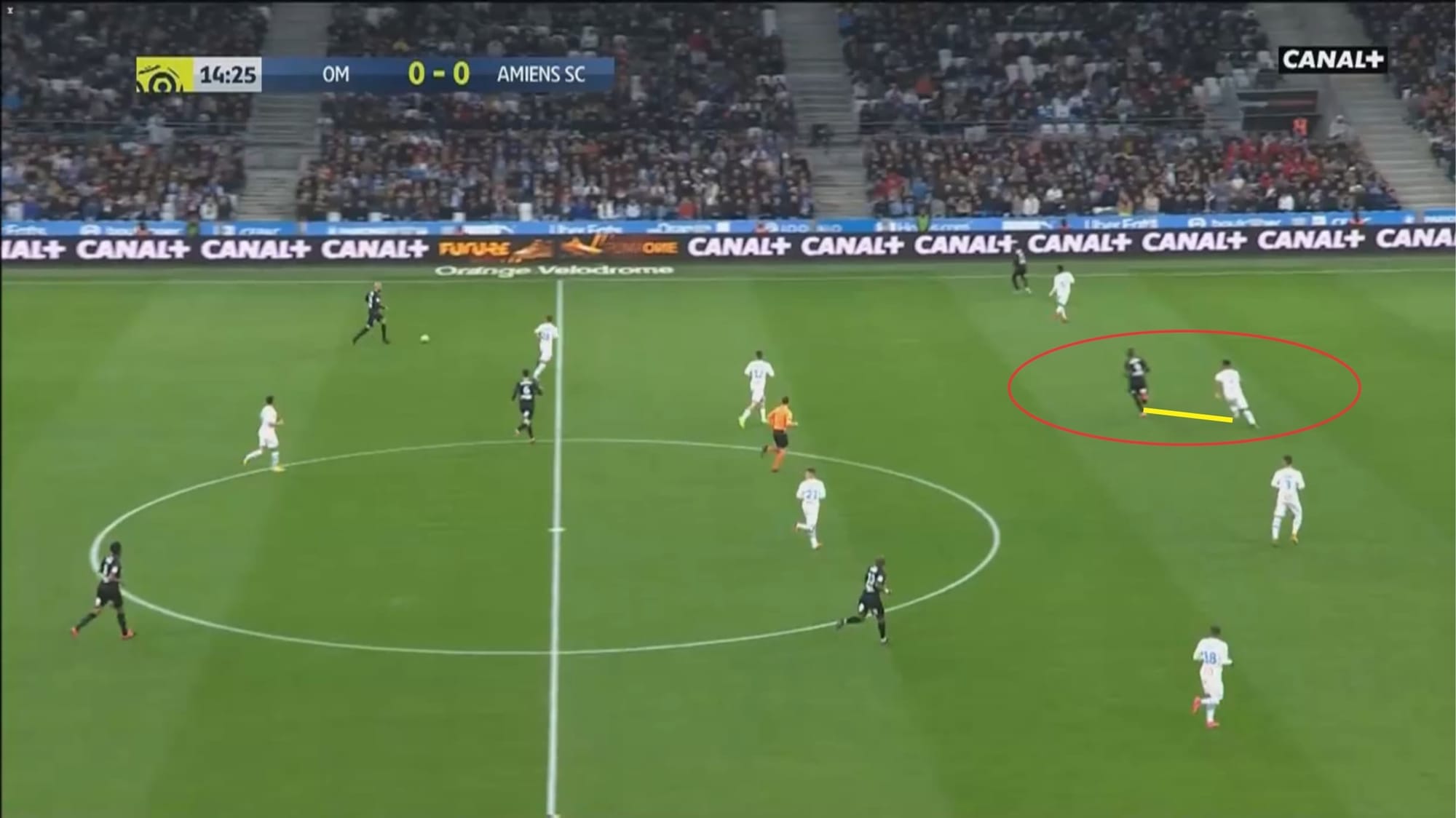
The image above is from Marseille’s match against Amiens last season. As you can see, the opposing striker was inside the centre-back’s defensive zone, so the Marseille centre-back would man-mark him.
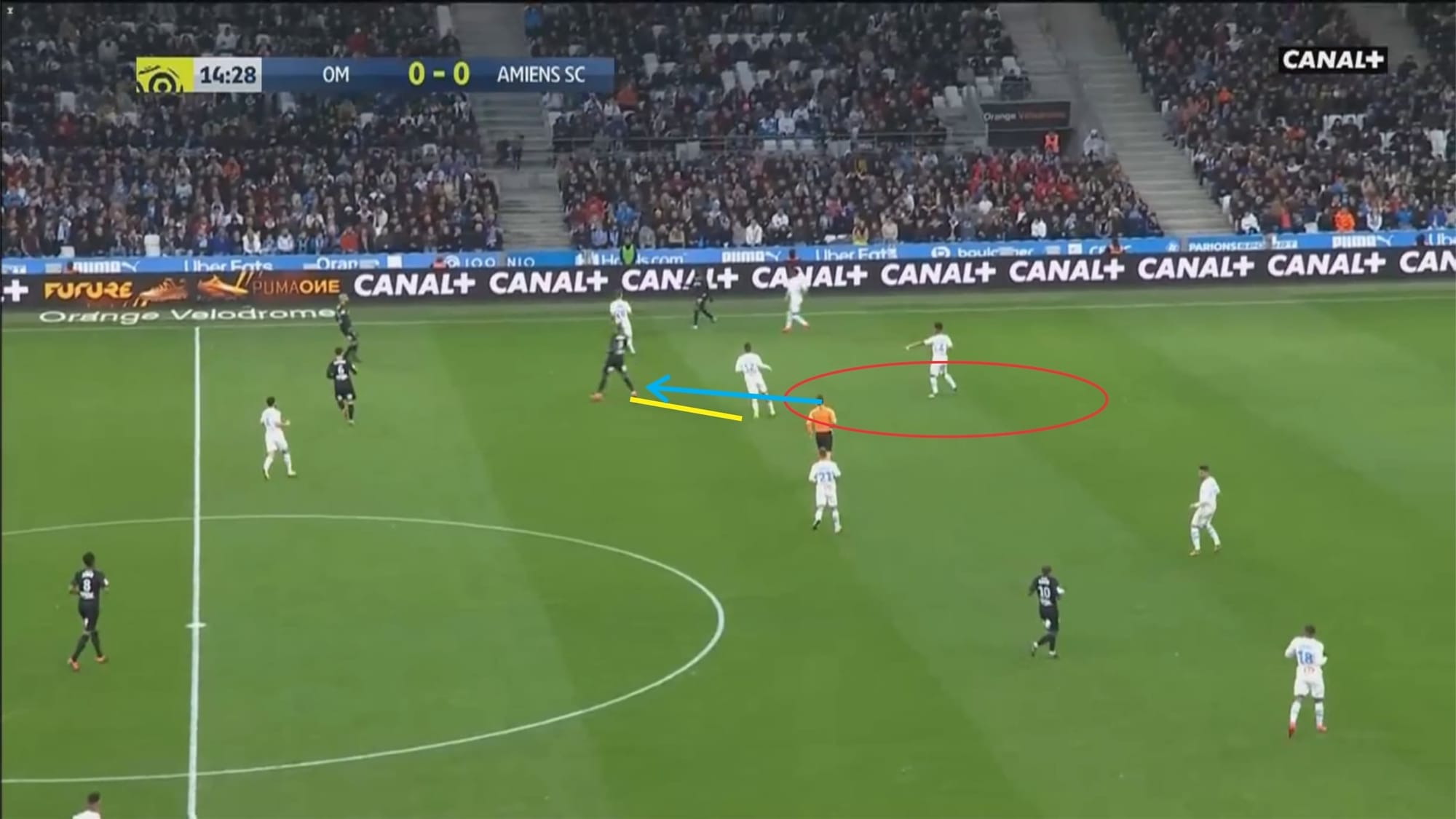
However, once the opposing striker stepped out of the defensive zone, the defender communicated with the defensive midfielder to mark him. For Marseille, constant communication is the key. However, this can be exploited by Lille.
By constantly moving around, swapping positions, and drifting in and out of the opposing defender’s defensive zone, Lille may be able to create dilemmas, force a mistake, and potentially create an opening in the structure. Creating overloads in a certain area of the field and double-teaming a defender could also be an ideal solution to break through Marseille’s defence.
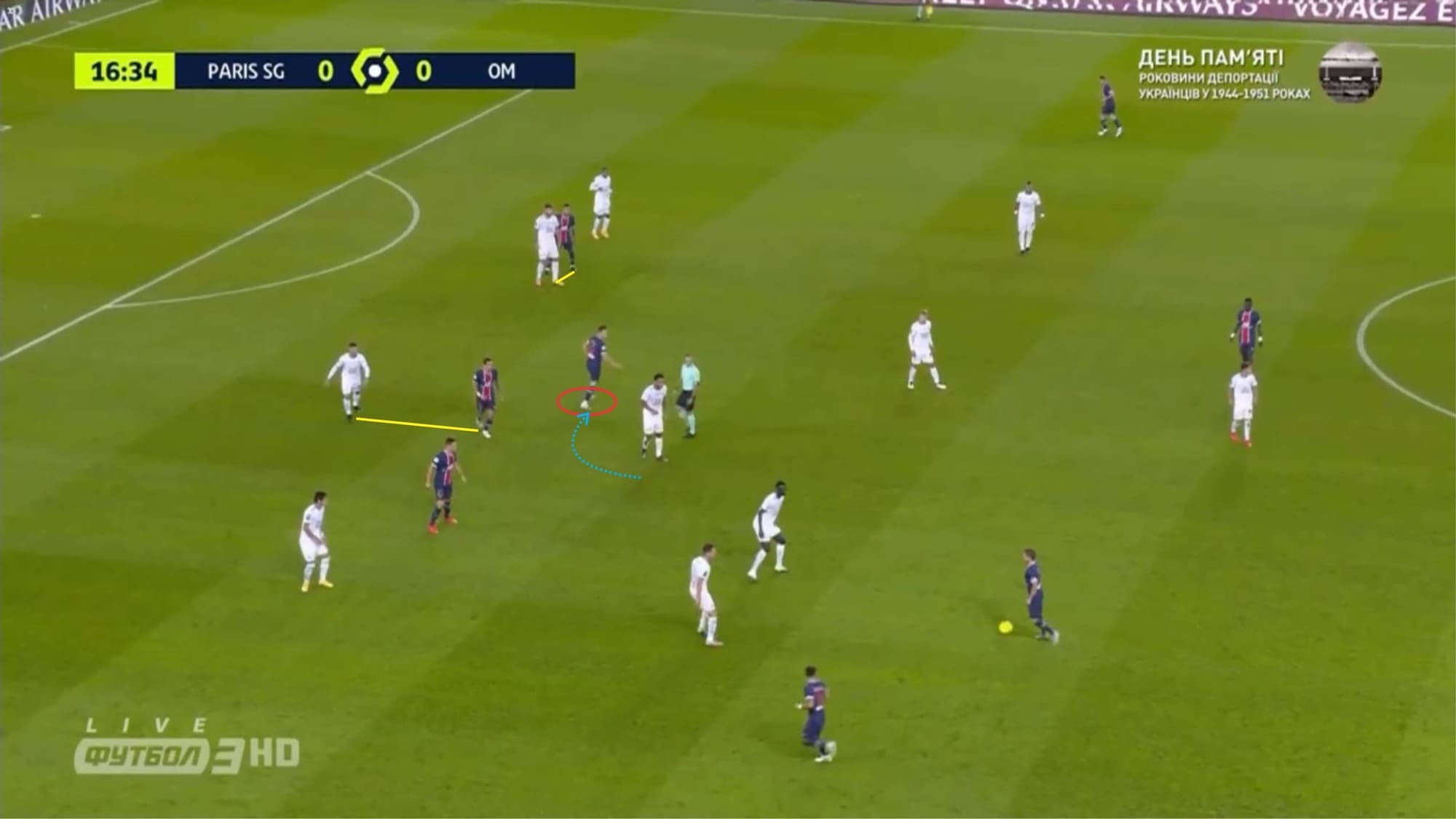
In the image above, for example, PSG created an overload in central areas. Both Marseille centre-backs were occupied by PSG’s forwards. You can also see that the player in the red circle (Pablo Sarabia) was originally marked by Marseille’s defensive midfielder. However, he moved towards the defensive midfielder’s blindspot. The defensive midfielder (Kamara) was too focused on the ball and was not aware of Sarabia’s movements.
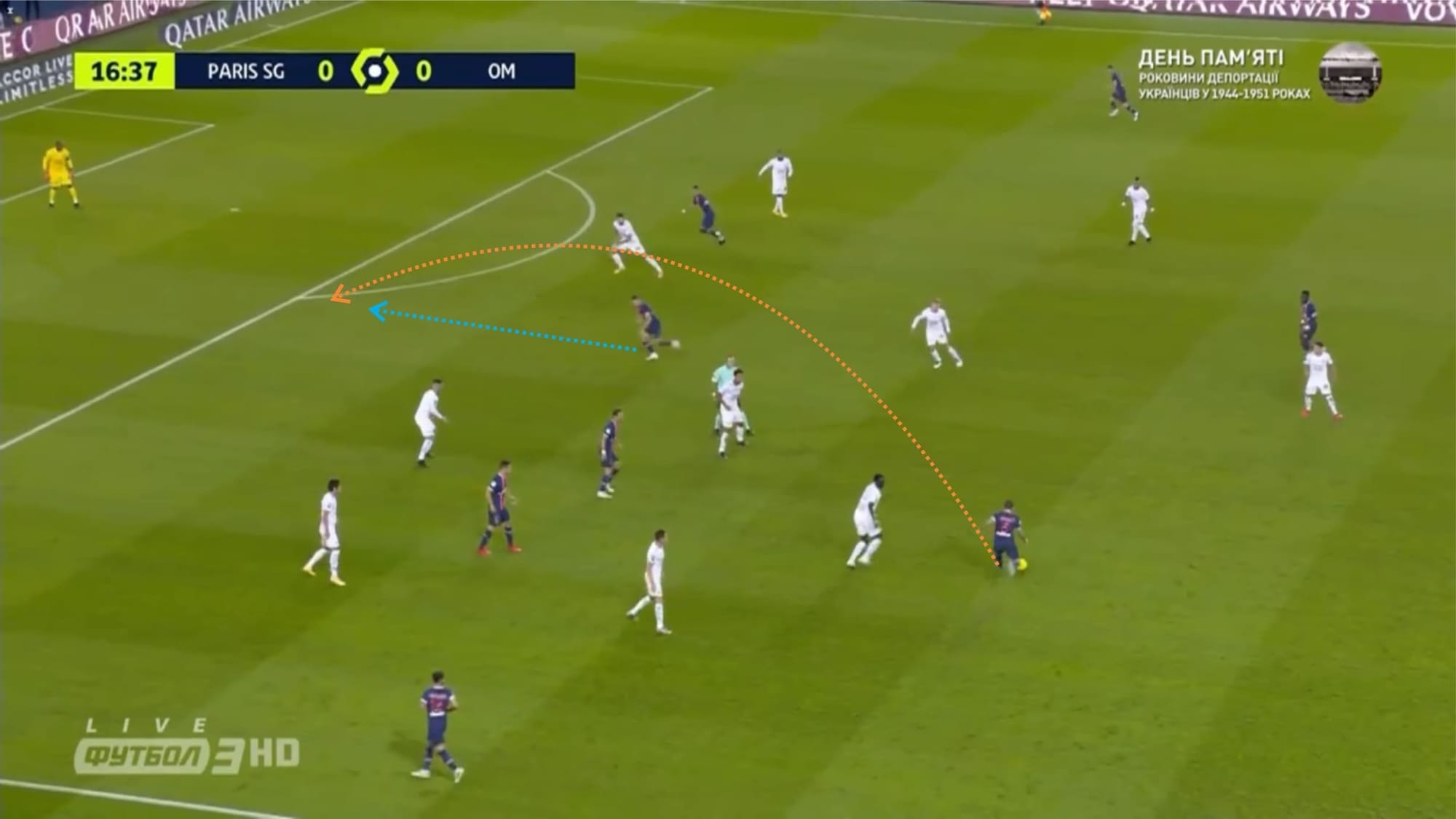
Sarabia saw the gap between Marseille’s centre-backs and immediately accelerated into the open space to receive Marco Verratti’s lofted pass. Sarabia, however, failed to control the ball properly in this case and PSG failed to create a meaningful chance despite the good team movements.
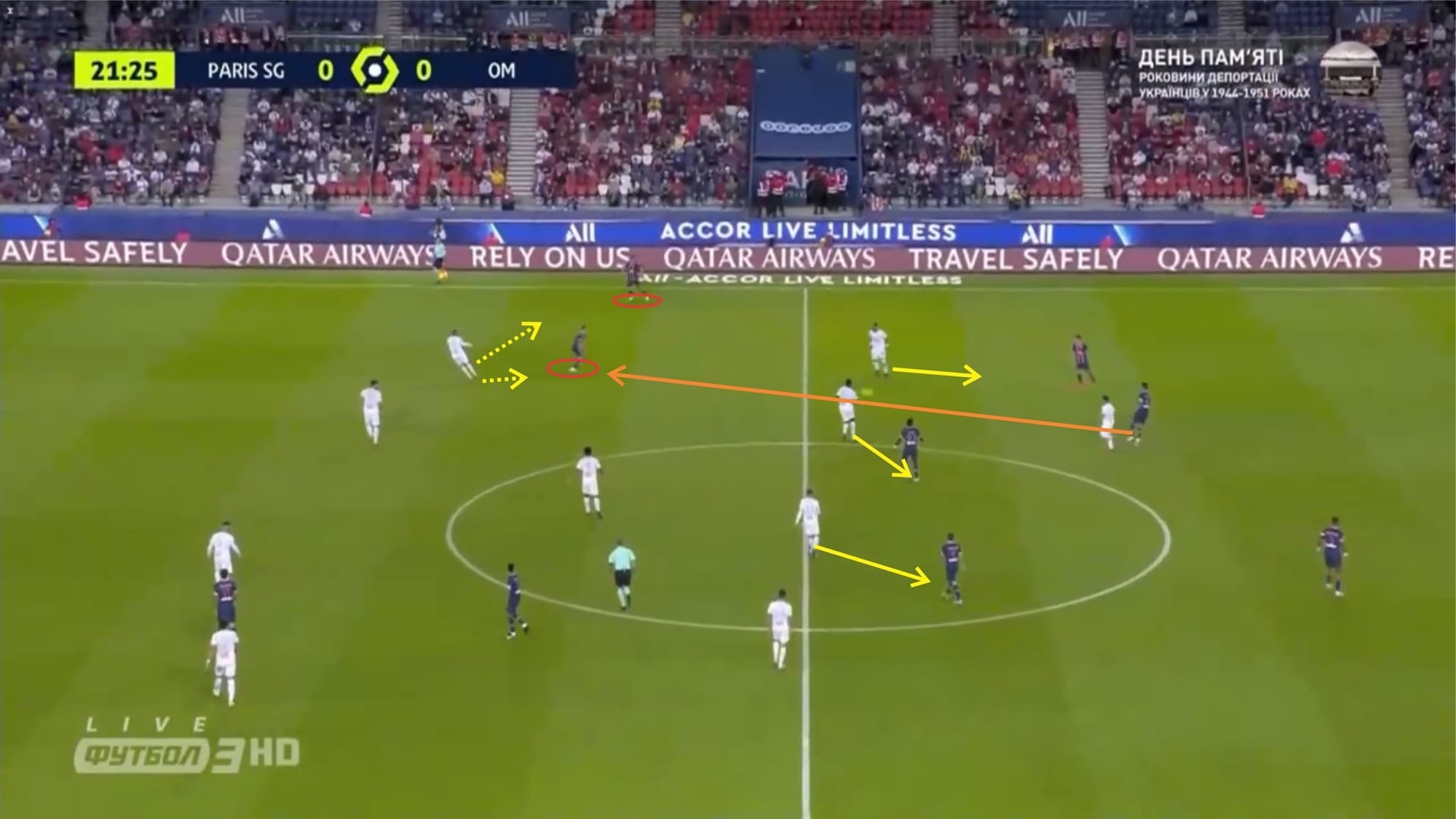
In the image above, PSG look to create a 2v1 situation the flank where the Marseille full-back would have to make a decision whether to step out of position or cover space. Firstly, PSG’s right-back can be seen sitting high up the pitch whilst the right-winger sat in the half-space, keeping the Marseille left-back busy. Both Marseille central midfielders were also occupied by PSG’s midfielders. Ander Herrera – who played as a right central midfielder – dropped from his position to create a back-three for PSG, attracting Payet’s attention in the process.
Thilo Kehrer saw a gap between Payet and Pape Gueye and immediately played a line-breaking pass towards the player in the half-space. Marseille’s left-back, in this case, decided not to press, allowing the ball PSG winger to receive comfortably and bring the ball forward by himself.
Conclusion
Both Marseille and Lille present a lot of interesting tactical tendencies in their first three matches in the 2020/21 Ligue 1 season. There are some changes in tactical tendencies from both teams compared to last season albeit not very significant.
Marseille have a good record against Lille, winning three of their last five meetings while the latter won only two out of five. The former Chelsea and Tottenham Hotspur manager would definitely like to extend their positive record with another win at home on Sunday. However, that certainly wouldn’t be an easy task at all. What is certain though, is that tomorrow’s match would provide a very interesting battle of tactics.
Will Marseille’s verticality thrive against Lille’s solid mid block? Or will Lille be able to break through Marseille’s defence and carve out chances in advanced areas? We shall see.

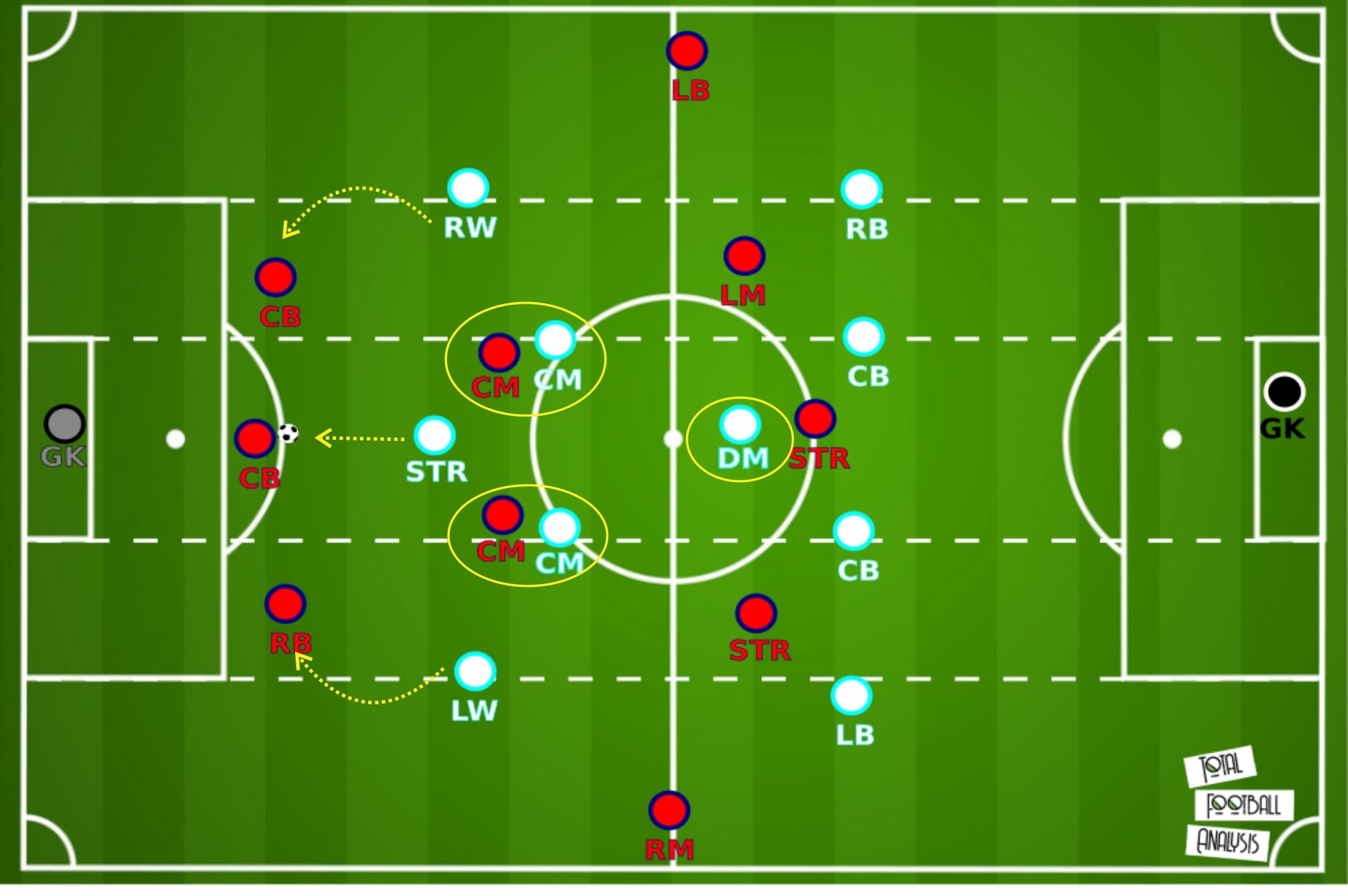



Comments